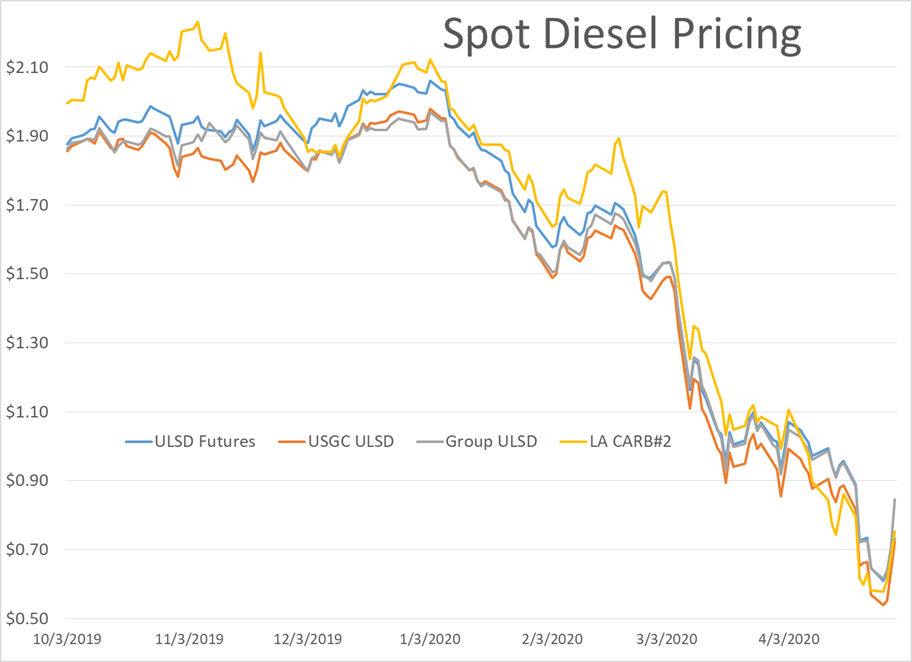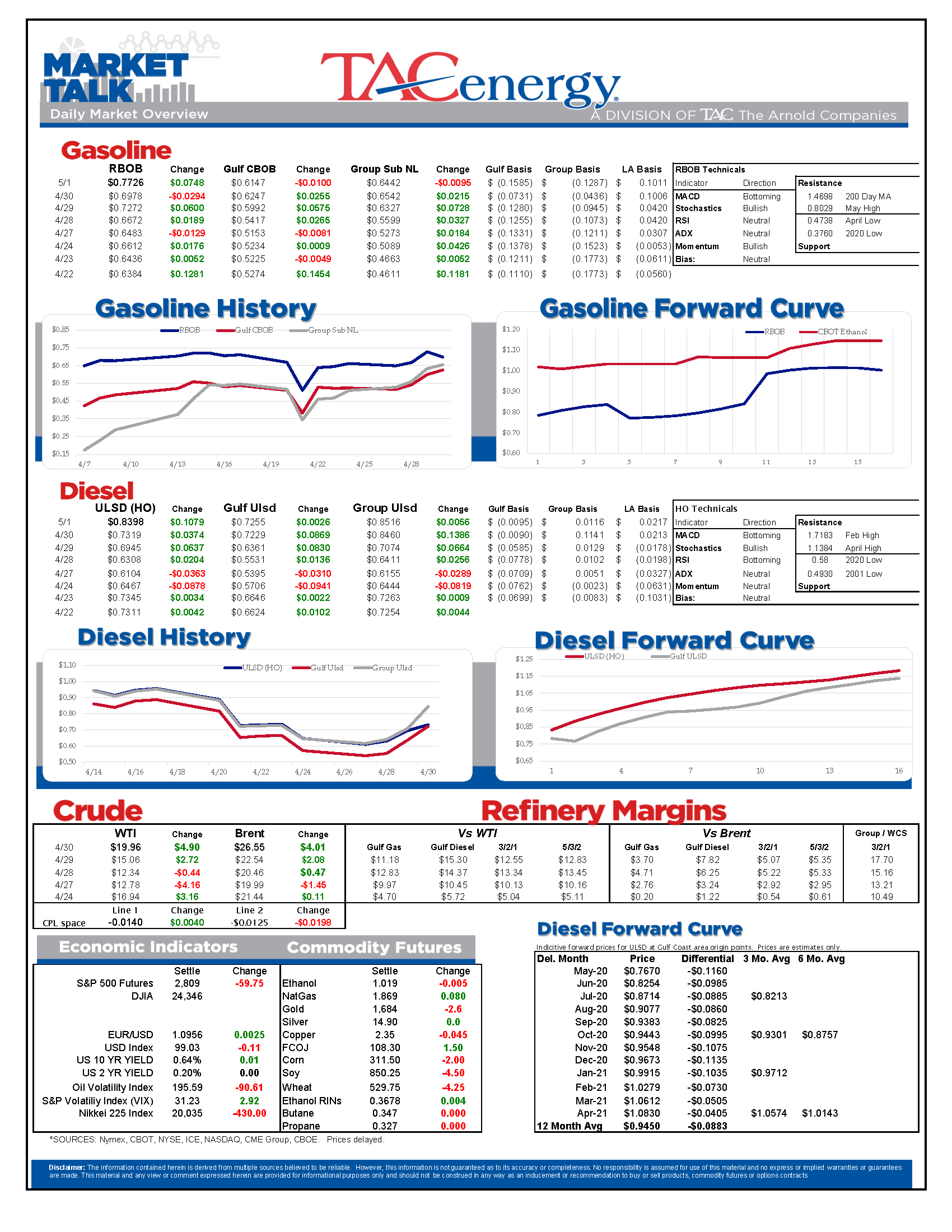Why Are Gasoline Prices Moving Lower Today?

A bumpy and disorganized overnight trading session seems to be a fitting way to start the month of May, as much of the world treads cautiously towards the beginning stages of reopening after six weeks of lock-down. May Day celebrations around the world will keep trading volumes lighter than normal today, adding to the choppy action.
Most energy contracts were selling off overnight only to rally back in the past hour, with June WTI breaking north of the $20 mark for the first time since the Monday melt-down. Refined products are also struggling for direction, with nickel trading ranges in the early going and mixed results across the contracts.
A good lesion in the difference between futures and physical prices: The expiration of the May RBOB and ULSD contracts in the midst of a super contango means the June contracts are trading some seven to 11 cents higher than where May left off, but those values don’t carry over to cash markets which are seeing minimal change so far today. This phenomenon is often misunderstood, and not often talked about since in normal times the calendar spreads in futures are a small fraction of where they are today. Ask anyone who was invested in the U.S. Oil ETF last week if they understand this lesson now.
Small oil companies in the U.S. have been defying the odds for years, outpacing production estimates consistently thanks to new drilling technology. It’s little wonder that these companies are now once again exceeding estimates in their ability to shut-in production faster than expected, which should help alleviate some of the near term storage concerns. There’s a new lifeline for some of these producers as one of several new Federal Reserve lending programs has been opened to the industry this week.
The opposite of a small oil company, ExxonMobil, released earnings this morning, showing a quarterly loss for the first time in years due to a $2.9 billion non-cash write down of inventory values. The statement noted weaker refining margins both in the U.S. and around the world, but its total downstream margins were high thanks to “favorable mark-to-market derivatives and improved manufacturing on lower scheduled maintenance.”
Wondering why May RBOB settled lower Thursday even when prices were higher at the close? Read about the difference in settlement procedures on expiration day here. That will also help explain why gasoline prices are moving lower today, even while a comparison to May’s settlement makes it appear that RBOB futures are sharply higher on the day. April was a month that broke the charts, so it seems fitting to end it with more confusion.
Normal Daily Settlement Procedure
NYMEX RBOB Gasoline (RB) futures are settled by CME Group staff based on trading activity on CME Globex during the settlement period. The settlement period is defined as: 14:28:00 to 14:30:00 ET for the Active Month and 14:28:00 to 14:30:00 ET for calendar spreads.
Final Settlement Calculation for Expiring Contract
On the day of expiration, the expiring month will settle based on the VWAP of the outright CME Globex trades executed between 14:00:00 and 14:30:00 ET.
Click here to download a PDF of today's TACenergy Market Talk.
Latest Posts
Week 16 - US DOE Inventory Recap
Energy Markets Trading Quietly In The Red As Ethanol Prices Rally To Five-Month High
The Struggle For Renewable Producers Continues As A Rapid Influx Of Supply And Crashing Credit Prices Make Biodiesel
After Years Of Backwardation, Diesel Prices Have Slipped Into Contango Over The Past Week
Social Media
News & Views
View All
Week 16 - US DOE Inventory Recap

Energy Markets Trading Quietly In The Red As Ethanol Prices Rally To Five-Month High
Energy markets are trading quietly in the red to start Wednesday’s session after a healthy bounce Tuesday afternoon suggested the Israel-Iran-linked liquidation had finally run its course.
There are reports of more Ukrainian strikes on Russian energy assets overnight, but the sources are sketchy so far, and the market doesn’t seem to be reacting as if this is legitimate news.
Ethanol prices have rallied to a 5-month high this week as corn and other grain prices have rallied after the latest crop progress update highlighted risks to farmers this year, lower grain export expectations from Ukraine, and the approval of E15 blends this summer despite the fact it pollutes more. The rally in grain and renewables prices has also helped RIN values find a bid after it looked like they were about to test their 4-year lows last week.
The API reported small changes in refined product inventories last week, with gasoline stocks down about 600,000, while distillates were up 724,000. Crude oil inventories increased by 3.2 million barrels according to the industry-group estimates. The DOE’s weekly report is due out at its normal time this morning.
Total reported another upset at its Port Arthur refinery that’s been a frequent flier on the TCEQ alerts since the January deep freeze knocked it offline and damaged multiple operating units. This latest upset seems minor as the un-named unit impacted was returned to normal operations in under an hour. Gulf Coast basis markets have shrugged off most reports of refinery upsets this year as the region remains well supplied, and it’s unlikely we’ll see any impact from this news.
California conversely reacted in a big way to reports of an upset at Chevron’s El Segundo refinery outside of LA, with CARBOB basis values jumping by more than a dime. Energy News Today continued to show its value by reporting the upset before the flaring notice was even reported to area regulators, proving once again it’s ahead of the curve on refinery-related events. Another industry news outlet meanwhile struggled just to remember where the country’s largest diesel seller is located.
Click here to download a PDF of today's TACenergy Market Talk

The Struggle For Renewable Producers Continues As A Rapid Influx Of Supply And Crashing Credit Prices Make Biodiesel
The sigh of relief selloff continues in energy markets Tuesday morning, with gasoline prices now down more than 20 cents in 7 sessions, while diesel prices have dropped 26 cents in the past 12. Crude oil prices are within a few pennies of reaching a 1 month low as a lack of headlines from the world’s hot spots allows some reflection into the state of the world’s spare capacity for both oil and refined products.
Gasoline prices are trading near a 6-week low this morning, but still need to fall about another nickel in order to break the weekly trendline that pushed prices steadily higher since December. If that trend breaks, it will be safer to say that we saw the end of the spring gasoline rally on April 12th for the 2nd year in a row. Last year RBOB futures peaked on April 12 at $2.8943 and bottomed out on May 4th at $2.2500. The high (at this point) for this year was set on April 12th at $2.8516, and the low overnight was $2.6454.
It’s not just energy commodities that are seeing an unwind of the “flight to safety” trade: Gold prices had their biggest selloff in 2 years Monday and continue to point lower today. Just how much money poured into commodities in the weeks leading up to the direct confrontation between Israel and Iran is unclear, but we have seen in year’s past that these unwind-events can create a snowball effect as traders can be forced to sell to cover their margin calls.
Supply > Demand: The EIA this morning highlighted the record setting demand for natural gas in the US last year, which was not nearly enough to offset the glut of supply that forced prices to a record low in February. A shortage of natural gas in Europe was a key driver of the chaotic markets that smashed just about every record in 2022, and an excess of natural gas supply in Europe and the US this year is acting as a buffer, particularly on diesel prices.
The struggle for renewable producers continues as a rapid influx of supply and crashing credit prices make Biodiesel, RD and SAF unprofitable for many. In addition to the plant closures announced in the past 6 months, Vertex Energy reported Monday it’s operating its Renewable Diesel facility in Mobile AL at just 50% of capacity in Q1. The truly scary part for many is that the $1/gallon Blender's tax credit ends this year and is being replaced by the “Clean” Fuel production credit that forces producers to prove their emissions reductions in order to qualify for an increased subsidy. It’s impossible to say at this point how much the net reduction will be for domestic producers, but importers will get nothing, and at current CI values, many biodiesel producers may see their “blend credit” cut by more than half.
Click here to download a PDF of today's TACenergy Market Talk.


